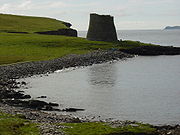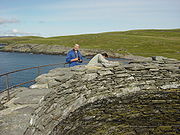
Mousa Broch
Encyclopedia

Mousa
Mousa is a small island in Shetland, Scotland, uninhabited since the nineteenth century. The island is known for the Broch of Mousa, an Iron Age round tower, and is designated as a Special Protection Area for storm-petrel breeding colonies.-Geography:...
is the finest preserved example of a broch
Broch
A broch is an Iron Age drystone hollow-walled structure of a type found only in Scotland. Brochs include some of the most sophisticated examples of drystone architecture ever created, and belong to the classification "complex Atlantic Roundhouse" devised by Scottish archaeologists in the 1980s....
or round tower in Shetland, Scotland
Scotland
Scotland is a country that is part of the United Kingdom. Occupying the northern third of the island of Great Britain, it shares a border with England to the south and is bounded by the North Sea to the east, the Atlantic Ocean to the north and west, and the North Channel and Irish Sea to the...
. It is the tallest still standing in the world and amongst the best-preserved prehistoric
Prehistory
Prehistory is the span of time before recorded history. Prehistory can refer to the period of human existence before the availability of those written records with which recorded history begins. More broadly, it refers to all the time preceding human existence and the invention of writing...
buildings in Europe
Europe
Europe is, by convention, one of the world's seven continents. Comprising the westernmost peninsula of Eurasia, Europe is generally 'divided' from Asia to its east by the watershed divides of the Ural and Caucasus Mountains, the Ural River, the Caspian and Black Seas, and the waterways connecting...
. It is thought to have been constructed circa 100 BC, one of 570 brochs built throughout Scotland. The site is managed by Historic Scotland
Historic Scotland
Historic Scotland is an executive agency of the Scottish Government, responsible for historic monuments in Scotland.-Role:As its website states:...
.
Description
It has one of the smallest overall diameters of any broch, as well as one of the thickest wall bases and smallest interiors; this massive construction (as well as its remote location) is likely to be the main explanation for its excellent state of preservation.Located on the island of Mousa
Mousa
Mousa is a small island in Shetland, Scotland, uninhabited since the nineteenth century. The island is known for the Broch of Mousa, an Iron Age round tower, and is designated as a Special Protection Area for storm-petrel breeding colonies.-Geography:...
(at ), it stands some 44 feet (13 m) high and is accessible via a single entrance at ground level. Once inside, a visitor may ascend an internal staircase to an open walkway at the top. It is the only broch which is complete right to the top, including the original intramural stair. It is built of dry stone
Dry stone
Dry stone is a building method by which structures are constructed from stones without any mortar to bind them together. Dry stone structures are stable because of their unique construction method, which is characterized by the presence of a load-bearing facade of carefully selected interlocking...
with no mortar
Mortar (masonry)
Mortar is a workable paste used to bind construction blocks together and fill the gaps between them. The blocks may be stone, brick, cinder blocks, etc. Mortar becomes hard when it sets, resulting in a rigid aggregate structure. Modern mortars are typically made from a mixture of sand, a binder...
, thus any disturbance could cause a great deal of damage. The characteristic hollow-walled construction is very clear at this site.
The broch went through at least two phases of occupation. In its original condition it doubtless contained a complex wooden roundhouse with at least one raised floor resting on a ledge or scarcement 7 ft (2.1m) above the ground. This floor was probably reached by the stone stair inside the wall. A second scarcement about 13 ft (3.09m) up could have supported a second floor or a roof. The entrance passage was low and lintelled with flat slabs and a water tank was cut in the underlying rock. There was also a large rectangular hearth resting on the rock.
Some time later a low stone bench was added round the base of the inside wall and this extended a short way into the entrance passage. The wooden roundhouse may have been demolished at this point; it was certainly demolished before the small wheelhouse (with three projecting stone piers) was built in the interior.
These Norse occupations are probably reflected in the fact that the original low lintels of the broch entrance have been torn out (their stumps can be seen), and the outer doorway doubled in height (it has now been restored to its original low level). This implies that the interior and the entrance were full of debris so the Norsemen had to raise the roof of the passage to get in.
In the National Museums of Scotland
National Museums of Scotland
National Museums Scotland is the organization that runs several national museums of Scotland. It is one of the country's National Collections, and holds internationally important collections of natural sciences, decorative arts, world cultures, science and technology, and Scottish history and...
in Edinburgh is a large rim sherd from the broch of Mousa, probably found during the 19th century clearance. It is part of a large Everted Rim jar with a black burnshed outer surface and horizontal fluting along the inner surface of the rim.
In January 2005 it was announced that archaeologists used 3D laser
Laser
A laser is a device that emits light through a process of optical amplification based on the stimulated emission of photons. The term "laser" originated as an acronym for Light Amplification by Stimulated Emission of Radiation...
scanning to catalogue the structure in detail for possible repairs. With the scans it is now possible to see how the structure was constructed in detail.

Storm Petrels
Mousa Broch is well known among birders for its breeding European Storm-petrelEuropean Storm-petrel
The European Storm Petrel or Storm Petrel is a small bird of the storm-petrel family, Hydrobatidae, part of the seabird order Procellariiformes. It is the only member of the genus Hydrobates.-Description:...
s, which are best after dark on partly or on completely overcast summer nights. The island holds c.6,800 breeding pairs in total, representing about 8% of the British population and about 2.6% of the world population. Some of these birds nest in burrows within the broch itself.
See also
- Oldest buildings in the United Kingdom

